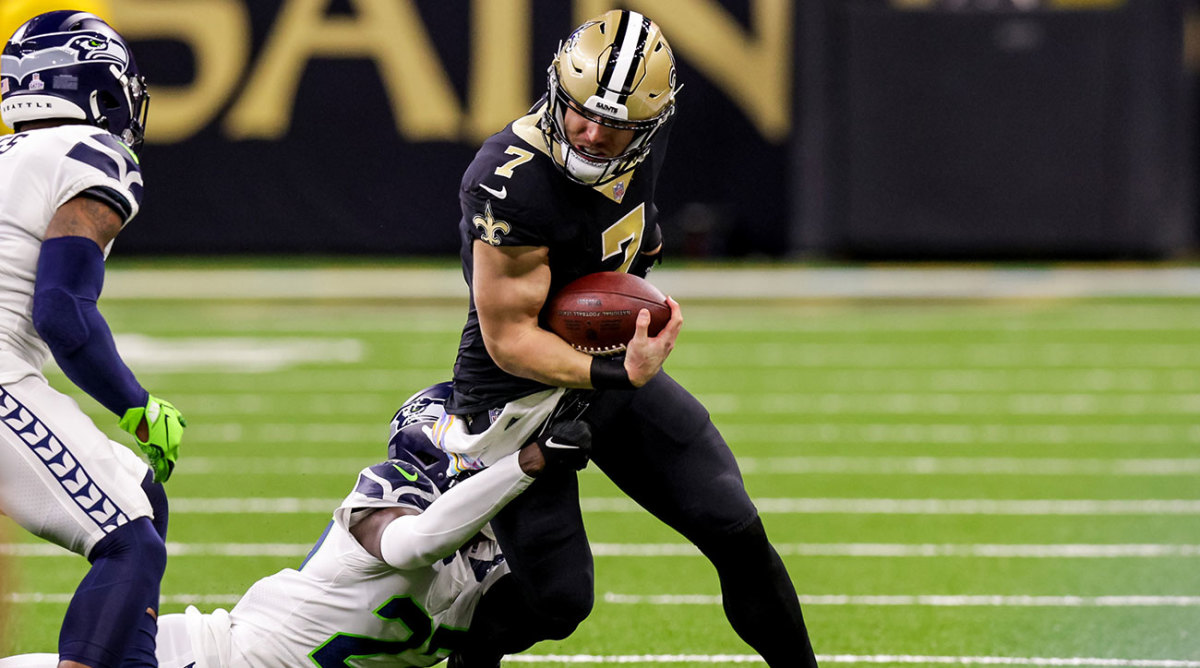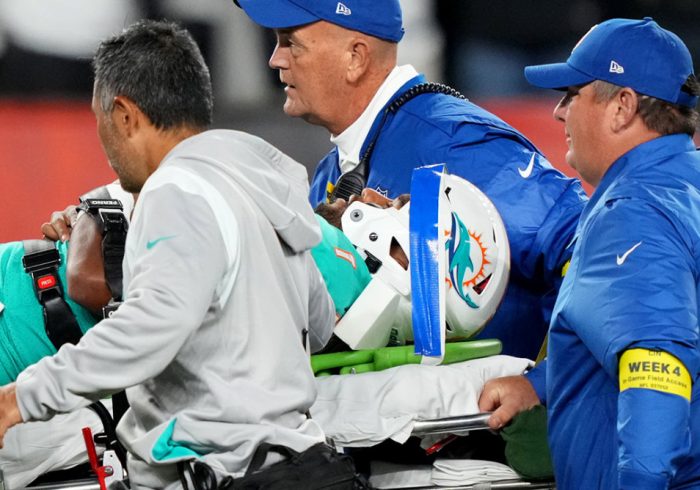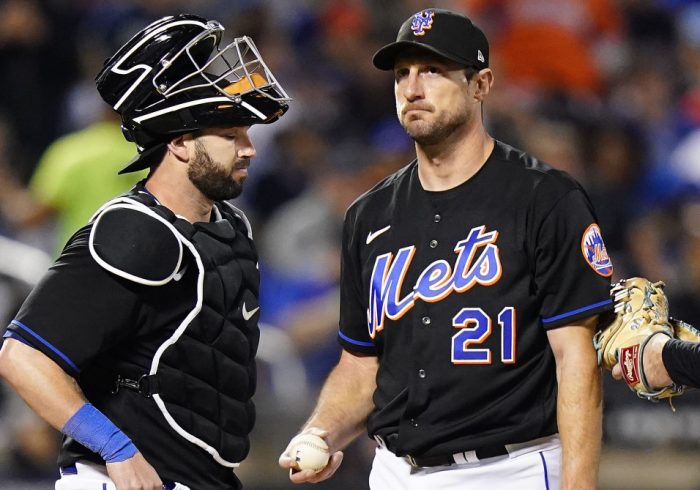First Taysom Hill was a gadget guy, and then he was the Saints’ quarterback of the future. After that, he lost a quarterback competition to Jameis Winston, so it was back to being a gadget guy, and that had to happen on the fly last year because he’d spent the whole offseason positioning himself to be the guy taking every snap.
And somewhere in there, Hill turned 32.
In case you were wondering, even at that advanced football age, Hill’s got plenty of juice left. Sunday’s wildly entertaining 39–32 win over the Seahawks at the Mercedes Superdome proved it beyond a shadow of a doubt. It also, in a certain way, came out of nowhere.
Hill carried the Saints past the Seahawks with 112 yards rushing on only nine attempts.
Stephen Lew/USA TODAY Sports
Hill, who battled a rib injury through September, played a total of 34 snaps in his first three games (he missed Week 2 against Carolina), had 12 touches in those games, and all of it was enough to ask what the Saints’ plans were for a guy they pay pretty well. Answers came in a flurry on Sunday. Hill had nine carries for 112 yards and three touchdowns, and he connected on his only pass attempt—to tight end Adam Trautman—for a fourth touchdown.
As for why this didn’t happen earlier? According to Hill, that’s mostly circumstantial.
“It certainly felt good [today],” he said. “And I think a new staff, we’ve all been kinda figuring this whole thing out. This was a game where we ran the ball very well, but we didn’t have to go away from the run game because we didn’t get behind. And I would say early in the season, we’ve been behind in games, and that kind of changed the way that we would like to call the game. It felt like this was a game that we were able to call the game the way that we’ve always wanted to and get to the plays that we really wanted to.
“Previously, we haven’t been able to do that.”
Indeed, the Saints fell behind 26–10 to the Falcons in the opener, 13–0 to the Panthers in Week 3 and 16–7 to the Vikings in Week 4, with the Buccaneers game in between all those taking on the look of a tractor pull, and Tampa pulling away late.
On Sunday, the Saints never trailed by more than seven, setting up the coaches to lean on Hill in the biggest moments.
The first came in the final minute of the third quarter, with New Orleans up 24–19, and in second-and-8 from the Seahawks’ 22. Hill, lined up in the shotgun as the quarterback for this snap, hadn’t logged a pass attempt all year, and it was time to break that tendency.
“That’s kind of the classic as an OC [offensive coordinator], you come in here and you talk about, Man, we want to run the ball well so we can set up our play-action pass. Let’s run the ball well to set up the pass game,” Hill said. “And we ran the ball very well in the first half with me at quarterback, and so as we came in at halftime, we said, Hey, we really like this play. And before it came in, I was kinda anticipating it on that second down. We were expecting a different look. But, man, Traut [tight end Adam Trautman] read it perfectly, and he saw the middle of the field open and took it.”
The result was Trautman sprinting free up the seam on a streak, and Hill finding him for a 22-yard touchdown, running through a defense anticipating the run.
That gave the Saints a 31–19 lead, but Seattle and red-hot quarterback Geno Smith weren’t done by a long shot. Rookie Kenneth Walker, in for the injured Rashaad Penny, gave Seattle a 32–31 lead with a 69-yard touchdown run. And once again, the Saints turned to Hill for the response.
Three plays after Walker’s run, for a third-and-1 from the New Orleans 40, Hill went in at quarterback.
“Third-and-short, and they obviously knew the quarterback run was coming and they were selling out to stop the run,” Hill said. “When you do that, if you get by the first level of defense, there’s just nobody there. So we were able to do that, and J.P. Holtz led me through there and made a big block that sprung me. And once you got to the outside, like I said, there was nobody left, and the rest was history.”
Hill won the ensuing footrace for the 60-yard touchdown to put New Orleans up for good.
And, in doing so, he punctuated a day that seemed to reintroduce him as a potential star in this new iteration, now that his time as a full-time quarterback seems to be done.
Hill confirmed that it does feel good that he’s finding his footing in a role in a different way than he’s held one before. At the same time, he’s aware the Saints’ offense has a lot of mouths to feed—Alvin Kamara and Chris Olave, as well as Michael Thomas and Jarvis Landry (neither of whom played Sunday) among them. So next week, to be sure, could look different than this week.
Which, Hill said, is just fine, because this might be the most talented skill group he’s been a part of in New Orleans.
“We’ve got a lot of really good football players on our team,” he said.
Sunday showed, again, that Hill is very obviously one of them.
The Broncos’ offense is struggling under coach Nathaniel Hackett and Russell Wilson.
Isaiah J. Downing/USA TODAY Sports
It’s easy to forget, given the running narratives, but the Broncos aren’t 0–5. They’re merely 2–3, and 2–3 with a manageable six weeks ahead schedule-wise (at Chargers, Jets, at Jaguars, at Titans, Raiders, at Panthers).
That said, there absolutely is reason for concern with where Denver’s going offensively.
The Broncos gave up two first-round picks, two second-round picks and three players to land Russell Wilson in the offseason, then did a five-year, $245 million extension with the 33-year-old that more or less marries the current regime to the quarterback, particularly with new ownership in place that wasn’t officially aboard until after the Wilson trade.
So for coach Nathaniel Hackett and GM George Paton, there really isn’t any room not to get it right with Wilson, and Thursday’s 12–9 loss to the Colts only illuminated issues that have already been there for a while. There was the 0-fer (4, if you’re counting) in the red zone. There was a third-down conversion rate under 15% (2-for-15). There were two picks, one the backbreaker to Stephon Gilmore. There was, in short, a lot.
And one thing to know is this—the Broncos staff sees what you do. On Friday, the coaches convened to do a self-study into what the offense has done well, and what it hasn’t, so they can keep working the scheme to fit the personnel in general, and Wilson in particular. One finding here, which has been obvious to those who’ve watched the team, was the lack of routine plays being made, and the feast-or-famine type of offense as a result.
Denver has made 31 plays it’d classify as explosives in the passing game through five weeks, which puts the Broncos at the top of the league in that category. The problem with that is those plays have happened, in part, out of necessity. They’re also in third-and-long more than anyone with the average distance on their third downs sitting in the neighborhood of a staggering 11 yards. In the Raiders game alone, the Broncos had 15 plays they call GBOTs (get back on track), where it’s first- or second-down-and-11-or-more.
Those are penalties. They’re sacks. They’re run plays failing. They’re a lot of things that have simply made everything harder for an offense run by a quarterback with receivers still learning things as basic as his cadence.
So maybe part of this was inevitable with a new quarterback in a new place, and as Hackett and his staff find their staple plays to fit his players that lead to routine, chain-moving sorts of gains, the rest will become easier. It’s fair, anyway, to expect that.
But there are a few other things to keep an eye on, too, that are part and parcel to Wilson and all that comes with him. I talked to a few guys over the weekend who’ve coached Wilson in the past who took me through some of that, and it can give you an idea of what to look for as Denver moves forward.
The first thing is how Wilson is deployed in the run. There was at least a perception in Seattle that Wilson didn’t want to be a quote-unquote running quarterback anymore. The problem with that is incorporating Wilson into the run game always helped open things up in the passing game for Wilson, and associated hard play-action was one way that the Seahawks could create vision for him over the middle, in generating throwing lanes with how the lineman pass-protected in those situations.
So is Wilson still willing to run? He did pull the rip cord late in the win over the 49ers. But the idea that he wants to be more of a Tom Brady–Peyton Manning type has lingered, and it’d be pretty difficult to expect success playing him that much in the dropback game. Either way, once that’s sorted out, it should help create more direction for the offense.
Then there’s the element of Russell Wilson, Inc. It’s no secret that Wilson’s fingerprints are all over the Broncos’ operation. His throwing coaches and therapists and workout coaches are around a lot, and there’s always been a perception that he’s got yes men around him. And that’s why one thing from the loss to the Colts really stuck out to one former Seahawks lieutenant that I spoke to.
“I let the team down tonight,” Wilson told the media after the Indianapolis game.
That, this person says, is big, because Wilson rarely publicly fell on the sword that way in Seattle. And it should at least help with his teammates as they work to figure out where they’re going as a team.
In the end, again, the guys running the Broncos now don’t have much of a choice but to get this right. We’ll see if they can.
But one thing is clear: The Wilson-Broncos marriage wasn’t ever going to work in the blink of an eye. Now it’s on everyone involved to make sure, in time, it actually does work. Because there’s a lot on the line for all of them.
The Chargers’ Michael Davis reacts after Browns kicker Cade York misses a game-winning field goal.
Ken Blaze/USA TODAY Sports
Chargers coach Brandon Staley can finally breathe a sigh of relief. After Sunday’s game, some 40 miles west of Brandon Staley’s hometown of Perry, Ohio, the Chargers coach gathered with family and friends from back home, and about 20 of his former players from his days as John Carroll’s defensive coordinator, many there with families of their own.
“I’m glad we were able to leave here a winner, for sure,” Staley told me from the bowels of FirstEnergy Stadium in Cleveland.
Doing so probably saved him a lot of grief Monday.
His Chargers showed a ton of determination in gutting out a 30–28 win over a very game Browns team, methodically battling back from a 14–0 deficit early, and doing so despite being down a number of cornerstone players, which we’ll get to. And they did it even though another big-box fourth-down decision from Staley went the other way.
The key moment happened with 1:14 left, and the Chargers’ holding the 30–28 lead. The ball was on their 46, and it was fourth-and-1. A punt would force Cleveland to drive the field. A conversion would end the game. A failed conversion would put the Browns on the fringe of rookie kicker Cade York’s range. I’ll let Staley take it from here.
“We just came here to finish the game with the ball,” he said. “And third down, we tried to have a run-up with a pass solution against a loaded box , tried to split it, but it didn’t happen. And then we knew that they were gonna have to deny the ball on fourth-and-short and we liked the matchup with Mike [Williams] on the slant and just felt like that would be the best matchup for us to finish the game with the ball.
“And the other thing was I felt like we would be able to cover them and keep them out of range. Their kicker had missed one. We knew that they were gonna have to throw it. They weren’t gonna be able to run it to get back in it, and I liked our matchups in pass coverage.”
The second part of Staley’s logic, it turned out, saved him and the Chargers. Browns rookie M.J. Emerson was able to break up Justin Herbert’s bid to get the ball to Williams on the slant, which gave Cleveland first-and-10 at the Los Angeles 45. And after that, as Staley projected, the Chargers’ pass defense clamped down. Jacoby Brissett was 1-of-5 from there, hitting a single 10-yarder and forcing York to kick a 54-yarder that sailed wide right.
Now, as for the aftermath, what you won’t hear here is an apology from the coach on his decision. Self-assuredly, he joked, “No one said anything about it last week when we sealed the game with it. Not one person said anything.”
And so, yes, he plans to keep taking chances others might not see as warranted.
“It’s all instincts, it’s all of the preparation that you do before the game,” he said. “And then, it’s, Hey, we had a kicking situation today. Our kicker wasn’t there; we had a backup kicker. There was wind today. So we wanted to be aggressive today, and that’s just the way the game went. And early in the game, we didn’t make it but we were able to respond as a team. But the mindset isn’t gonna change around here in terms of putting the ball in our best players’ hands and trying to figure it out.”
The upshot here is Staley’s group wound up making his decision-making stand up, which happens more often than it doesn’t, and in doing so that group also reinforced what was on display last week, too—that the team Staley has, even with the injury situation being what it is, is still more talented than most. Winning consecutive games on the road right after losing Joey Bosa and Rashawn Slater is proof positive.
“We wanted to build this team so we could absorb some things like that,” Staley said. “And I think that it goes back to the Spanos family, [GM] Tom Telesco, myself, our staff, trying to build a football team that can withstand stuff like this, because it’s just normal in the NFL. So you go Keenan Allen down for four games, and we’ve had guys step up. Dre [DeAndre Carter], Josh Palmer, [Michael] Bandy, [Jason] Moore. They step up. Mike Williams has been huge the last couple weeks.
“Our tight end group has been huge, picking up the slack, because when you’re without Keenan Allen, one of the best receivers in football, everyone’s gotta share the load. Don’t forget Justin [Herbert], he’s been playing hurt, too. What we’ve been able to do is show our resiliency. We’ve been able to absorb the first part of the year. We’re gonna be getting guys back. But you gotta be able to do this in the NFL. You gotta be able to win tough and rugged.”
And, O.K., maybe they did take a less-worn path to get there.
But no one’s apologizing for it.
More NFL Coverage:



